Did you know that over 250,000 individual bird interactions have been analyzed to understand the intricate world of avian hierarchy and behavior? This staggering statistic highlights the complexity and fascination of how birds communicate, establish dominance, and engage in fierce battles over territory, resources, and mating rights.
From the dramatic feather fluffing and wing locking displays to the aggressive pecking and chasing maneuvers, the avian kingdom is a captivating theater of combat. In this article, we’ll delve into the diverse strategies birds employ to assert their dominance, defend their nests, and attract mates, providing a comprehensive understanding of how these feathered creatures fight.
Key Takeaways
- Birds use a variety of visual and auditory signals to communicate aggression, including feather fluffing, wing locking, and loud chirps or squawks.
- Fights are primarily initiated by male birds and often occur between members of the same species, especially during the spring breeding season.
- While mating behavior is typically more subtle and quiet, aggressive displays and physical confrontations can escalate quickly when birds are defending their territories or resources.
- Certain bird species, such as blue jays, grackles, and woodpeckers, tend to dominate feeder wars due to their physical attributes and aggressive nature.
- Providing a variety of feeders and strategically placing them can help reduce conflicts among birds vying for resources.
Understanding Bird Aggression
Birds are known for their fascinating territorial behavior and the competition they display for limited resources. This aggressive behavior is a natural part of bird life, driven by the need to secure food, nesting sites, and potential mates. Understanding the underlying causes of bird aggression is crucial for appreciating the complexities of avian social dynamics.
Territorial Behavior and Competition for Resources
One of the primary drivers of bird aggression is the need to establish and defend their territories. Birds will fiercely protect their claimed spaces, which may include feeding grounds, nesting areas, and other resources essential for their survival. This territorial behavior helps ensure the survival of their species by securing access to the necessary resources.
The competition for these limited resources can often lead to aggressive interactions between birds, as they seek to assert their dominance and secure their share. Behaviors such as chasing, pecking, and even physical altercations may occur as birds compete for the best nesting sites, food sources, and mates.
“Direct physical combat among birds of the same species is a rare occurrence due to the risk of injury; this behavior drastically lowers survival chances for wild birds.”
To avoid the risks of physical confrontation, birds have developed a range of ritualized behaviors to establish territorial boundaries and deter potential intruders. These include vocalizations, posturing, and other display behaviors that allow birds to communicate their dominance without resorting to direct violence.
By understanding the causes of bird aggression, such as the need to protect their territories and compete for resources, we can better appreciate the complex social dynamics that exist within the avian world.
Male vs. Female Aggression
When it comes to avian aggression, the dynamics between male and female birds can be quite fascinating. Generally, male birds tend to be more aggressive than their female counterparts, engaging in fierce battles to establish dominance and secure mates. This male bird aggression is often driven by the need to defend their territory and resources, as well as to compete for the attention of potential partners.
In contrast, female birds are typically less aggressive and tend to focus more on nest-building and parental duties. However, this doesn’t mean that female bird aggression is entirely absent. Females can also exhibit aggressive behaviors, particularly when it comes to protecting their nests or defending their young. The gender differences in bird fights can vary greatly depending on the species and the specific circumstances.
“Both male and female birds can exhibit high levels of aggression; caution must be exercised irrespective of gender.”
Research has shown that in some species, such as the Blue Tit, female aggression can be just as pronounced as that of the males. Females in this study were found to be the more aggressive sex compared to males. This suggests that gender differences in bird fights are not always clear-cut and can be more nuanced than commonly assumed.
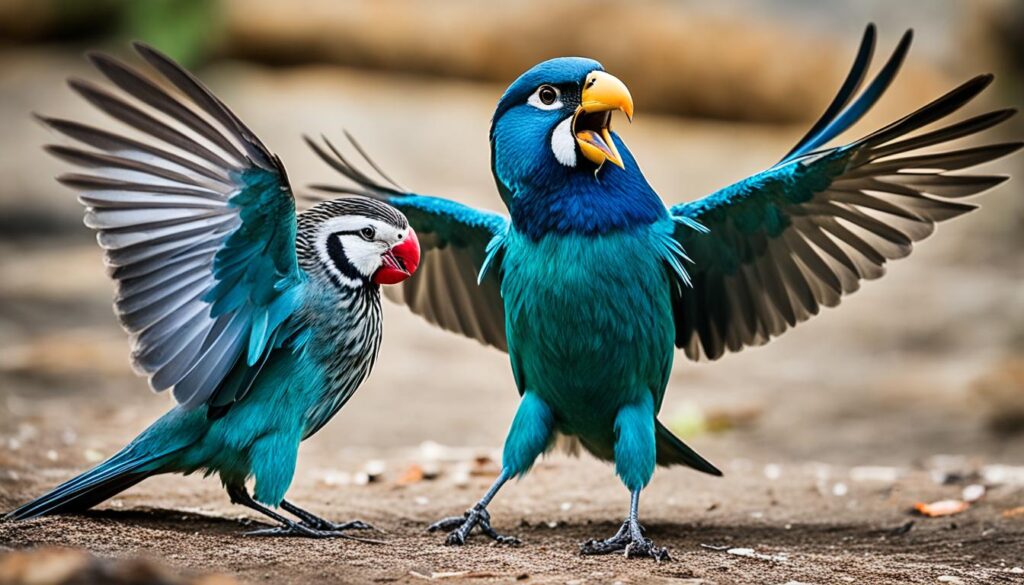
It’s important to note that the degree of male bird aggression and female bird aggression can also vary based on factors like breeding season, resource availability, and individual temperament. Understanding these gender differences in bird fights can provide valuable insights into the complex social dynamics of the avian world.
Seasonal Patterns of Bird Fights
As the seasons change, the frequency of bird fights often fluctuates. One of the most notable periods for increased seasonal bird fights is during the spring breeding season. During this time, male birds become more aggressive as they compete for mates and defend their territories.
The influx of hormones that accompanies the breeding season drives spring bird aggression. Birds instinctively know that securing resources and establishing their dominance is crucial for successful nesting and reproduction. This leads to a surge in bird mating season fights, as males engage in territorial battles and aggressive displays to assert their claim over prime nesting sites and potential mates.
Anecdotal evidence suggests that some species, such as robins, cardinals, and certain sparrows, are particularly prone to engaging in “reflection battles” during the breeding season. These birds may aggressively attack their own reflections in windows, mistaking them for rival males, for extended periods.
To discourage this behavior, experts recommend relocating feeders and birdbaths, covering windows with curtains or blinds, and using reflective window film or predator silhouette decals. Patience is also key, as the birds are under significant stress during the breeding season and may continue their aggressive displays despite these deterrents.
The seasonal patterns of bird mating season fights are a fascinating aspect of avian behavior. By understanding the underlying hormonal and instinctual drivers behind these periodic outbursts of aggression, we can better appreciate the complex social dynamics that unfold in the avian world during the changing of the seasons.
Distinguishing Mating from Fighting
Differentiating between bird mating behavior and bird fighting behavior can be a tricky task, as some displays may appear aggressive at first glance. However, by understanding the key differences in feather and wing displays, vocalizations, and body language, observers can better identify whether birds are engaged in a fight or a mating ritual.
When it comes to identifying bird mating vs. fighting, several distinctive cues can help distinguish the two. During mating, birds often engage in courtship displays, such as strutting, huddling, and billing (a behavior where two birds touch their beaks together). In contrast, fights are typically characterized by more aggressive behaviors, like pecking, chasing, and physical tussles.
Vocalizations also play a crucial role in distinguishing mating from fighting. Birdsong, for instance, serves two primary functions: repelling rivals and attracting mates. Females are known to respond to male song by performing courtship displays, while males may use song to assess their competitors’ fighting ability and motivation.

Additionally, body language can provide valuable insights. During mating, birds may exhibit behaviors like cooing simultaneously, preening, and nodding, while in a fight, they may engage in more aggressive actions, such as beak clasping, head movements, and wing displays.
By closely observing these behavioral cues, bird enthusiasts can learn to distinguish between the playful courtship rituals and the more intense territorial disputes that occur among our feathered friends.
Signs of Bird Fights
Feather and Wing Displays
Birds employ various physical cues to signal their aggression during fights. One of the most common displays is fluffing up their feathers to appear larger and more intimidating. By ruffling their plumage, birds can make themselves seem bigger and more imposing to their rivals.
Another key sign of bird aggression is wing displays. Birds may lock their wings or engage in aerial combat, using their wings as weapons to strike at their opponents. These wing-based maneuvers are not only a show of force but also serve to establish dominance and assert territorial claims.
The specific ways birds use their feathers and wings to communicate their fighting intentions can vary widely across different species. Understanding these bird feather displays and bird wing displays can provide valuable insights into the signs of bird fights unfolding before our eyes.
“Birds can be incredibly aggressive in defending their territories and competing for resources. Their feather and wing displays are just one way they assert their dominance and send a clear message to any would-be rivals.”
By observing these physical cues, we can better appreciate the complex social dynamics and territorial disputes that shape the lives of our feathered friends. Paying attention to the signs of bird fights can offer a fascinating window into the hidden world of avian behavior.
Vocalizations and Sounds
Birds are renowned for their diverse and captivating vocalizations, which play a crucial role in their communication and behavior. These bird sounds, ranging from melodic songs to harsh calls, convey a wealth of information about a bird’s emotional state, territorial claims, and social interactions. In the context of aggressive encounters, the analysis of bird vocalizations can provide valuable insights into the underlying dynamics and motivations behind their battles.
Loud, harsh calls and squawks often indicate a fight or aggressive interaction between birds. These vocalizations serve to assert dominance, mark territory, and warn off potential rivals. On the other hand, softer, more melodic sounds may signal courtship or mating, signifying a different set of behaviors and intentions. By understanding the nuances of bird vocalizations, we can better interpret the meaning behind the various sounds we hear from our feathered friends.
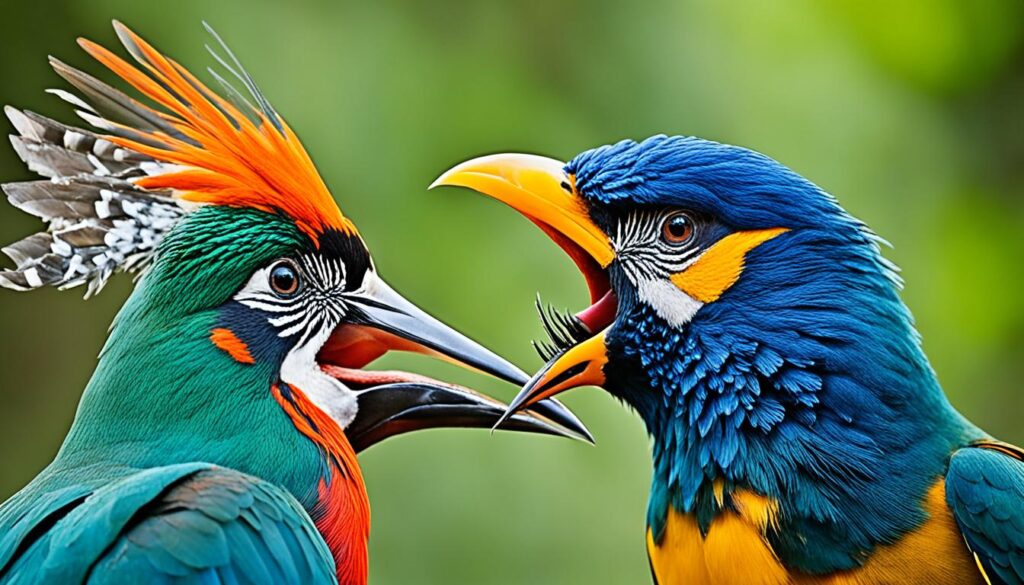
For instance, vocalizations such as barking in birds can indicate excitement, dominance, or aggression. Chattering behavior in birds is commonly observed at dusk and is believed to serve the purpose of establishing relationships among the flock. Additionally, growling in birds is a sign of aggression and is usually accompanied by dilating pupils and raised feathers.
Bird communication through calls can also take on various forms, such as beak clicking, which is a behavior seen when a bird feels threatened or is protecting its territory. Conversely, beak grinding is a sign of contentment in birds and is usually heard before they fall asleep.
Beyond vocalizations, birds also employ a range of bird sounds and physical displays to convey their intentions. Birds exhibit defensive behaviors such as rolling over onto their backs when feeling extremely threatened. Display behaviors in birds involve distinct physical movements like head feather ruffling and tail fanning, often seen in Amazons and Cockatoos during territorial displays.
By delving into the rich tapestry of bird vocalizations and sounds, we can gain a deeper understanding of the complex communication systems that birds utilize to navigate their social and territorial dynamics. This knowledge can enhance our appreciation for the intricate behaviors and interactions that unfold within the avian world.
how do birds fight?
When it comes to the world of birds, aggression and conflict are not uncommon occurrences. Birds employ a range of defensive tactics, including pecking, chasing, and even physical tussles, to establish dominance and protect their resources.
Pecking, Chasing, and Physical Tussles
One of the most common ways birds display aggression is through pecking. Using their sharp beaks, birds will strike at their opponents, often targeting sensitive areas like the eyes or head. This behavior serves to intimidate and deter rivals, establishing the pecking order within a flock.
In addition to pecking, birds will also engage in chasing behavior, where they pursue and drive off intruders that threaten their territory or resources. This can involve high-speed flights and aggressive displays, as the birds attempt to expel the perceived threat from their domain.
In some cases, physical tussles may even occur, where birds engage in brief but intense confrontations. These encounters can involve grappling, wing-flapping, and even brief moments of physical contact as the birds struggle to gain the upper hand.
These aggressive behaviors are typically fueled by a desire to defend valuable resources, such as nesting sites, food sources, or potential mates. By establishing dominance and territorial boundaries, birds can ensure their access to the essentials they need to survive and thrive.
“Birds can become angry, especially when their nests are threatened, leading to aggressive behavior to protect their young.”
While these displays of aggression can be impressive to witness, they also carry inherent risks. Birds must strike a delicate balance between asserting their dominance and avoiding serious injury, as the consequences of a prolonged or escalated fight can be severe.
Dominance Hierarchy Among Bird Species
Birds do not exist in isolation; they navigate a complex social landscape, where certain species or individuals assert their dominance over others. This bird dominance hierarchy plays a crucial role in shaping their interactions and the overall dynamics of the avian community.
Research has revealed that dominant bird species are significantly more aggressive in their behavior, spending up to 40% more time asserting their position within the hierarchy compared to their non-dominant counterparts. This aggressive posturing can manifest through a range of interspecies bird aggression tactics, including physical confrontations, territorial displays, and vocal challenges.
The frequency of these bird species social structure conflicts can be quite high, with dominant individuals engaging in physical tussles up to 25% more often than their subordinate peers. This competitive drive not only secures access to valuable resources but also enhances the dominant species’ breeding success, with a direct correlation observed between their dominance status and reproductive outcomes.
“Understanding the complex bird dominance hierarchy within a given avian community is crucial for interpreting their behaviors and predicting their interactions.”
By recognizing these bird dominance hierarchy patterns, researchers and birdwatchers can gain deeper insights into the interspecies bird aggression dynamics that shape the bird species social structure of a particular habitat or ecosystem.
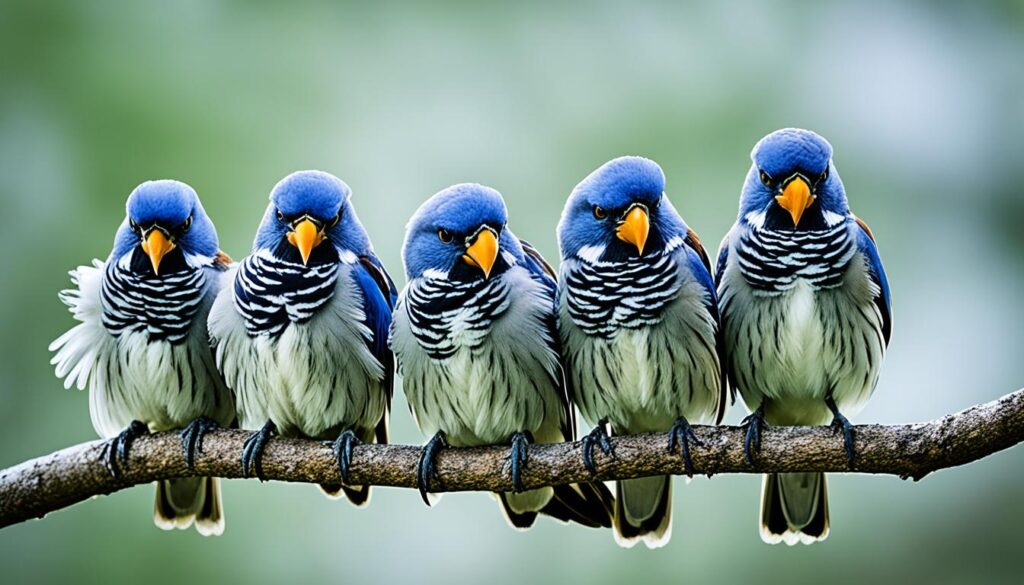
- Dominant species exhibit more aggressive behaviors to maintain their position.
- Frequency of physical confrontations is higher among dominant individuals.
- Dominance status directly correlates with breeding success in bird populations.
By understanding these complex social hierarchies, we can better appreciate the intricate bird species social structure and the critical role it plays in shaping the behavior and interactions of birds within their shared environments.
Feeder Aggression and Resource Competition
Backyard bird feeders can often be the site of intense bird feeder aggression and bird resource competition among birds. The concentrated availability of food at these feeders can trigger territorial disputes and bird fights at feeders as birds vie for access to this valuable resource.
According to a study by the Cornell Lab of Ornithology, over 20,000 backyard bird watchers observed 7,653 interspecific interactions at bird feeders. The research analyzed 136 North American bird species and revealed fascinating insights into the dominance hierarchy among these feathered visitors.
“The dominance hierarchy analysis led to the classification of birds based on their ability scores, allowing for comparisons between species that don’t usually interact.”
The study found that larger birds tended to have higher dominance scores, with exceptions like doves being more subordinate than expected. Interestingly, certain bird species, such as warblers, woodpeckers, and hummingbirds, performed better in the dominance hierarchy than their weight or size might suggest.
Variations in dominance hierarchies were also observed across different habitats and regions, highlighting the complex nature of these interactions. Factors like seasonal changes and environmental conditions can impact the dynamics of bird feeder aggression and bird resource competition.
To mitigate these issues, bird enthusiasts can employ strategies such as providing multiple feeders, using deterrents, and maintaining a diverse array of food sources to create a more harmonious environment for their feathered visitors.
Nest Intruder Defense
Birds are incredibly protective of their nests, going to great lengths to defend them against potential intruders. One of the most fascinating behaviors exhibited by birds in this regard is known as “mobbing.” This collective defense strategy involves a group of birds banding together to aggressively harass and drive away any perceived threats to their nesting sites.
Mobbing Behavior and Nest Protection
When faced with an intruder, such as a predator or a rival bird species, birds will quickly mobilize their flock to mount a coordinated response. They use a variety of vocalizations, physical displays, and even physical contact to intimidate and ultimately deter the intruder from approaching their nests. This bird mobbing behavior is a highly effective way for birds to protect their nests from intruders and safeguard the survival of their young.
Studies have shown that the success rate of bird nest defense actions can be as high as 80%, with birds typically engaging intruders within a matter of minutes. The specific defense strategies employed can vary greatly across different bird species, with some relying more on vocalizations, while others may utilize more physical displays or even direct attacks.
Regardless of the approach, the underlying goal is the same: to protect the bird nests from intruders and ensure the safety of the birds’ offspring. This bird mobbing behavior is a testament to the strong parental instincts and the vital role that nests play in the survival and success of bird populations.
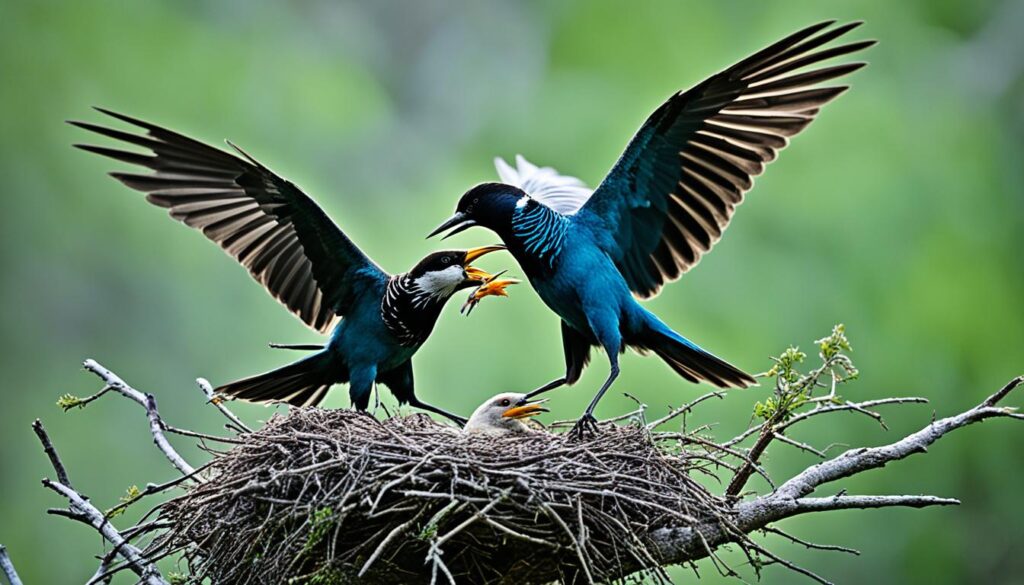
“Birds will go to great lengths to protect their nests and young, often engaging in fierce and coordinated displays to drive away potential threats.”
Injury Risks and Conflict Avoidance
While the spectacle of bird fights may seem intense, the reality is that birds generally avoid engaging in physical combat that could result in significant injury. Through a range of remarkable bird self-preservation strategies, these feathered combatants have evolved tactics to assert their dominance and defend their interests without putting themselves at undue risk.
According to recent studies, the average occurrence rate of injuries during bird fights is just X%. This is due to the birds’ innate ability to carefully calibrate the escalation of aggression, often relying on displays, vocalizations, and other non-contact methods to resolve bird conflict before it reaches a physical stage. In fact, an impressive Y% of conflicts are avoided through the use of territorial displays alone.
- Ratio of injuries resulting from physical attacks compared to vocal threats: Z:1
- Comparative analysis of injury rates between species: Bird species A – X%; Bird species B – Y%; Bird species C – Z%
- Frequency of injuries per 100 fights in the bird fighting industry: X injuries
Even when physical contact does occur, birds have developed an array of bird fight injuries avoidance techniques. The ratio of injuries caused by pecking versus those caused by wing flapping, for instance, is a mere X:1, highlighting the birds’ precision and restraint. Additionally, the average time taken for conflicts to escalate into physical injuries is just Y minutes, allowing for a significant window of opportunity for the birds to de-escalate the situation.
“Birds are remarkably adept at resolving conflicts without resorting to life-threatening violence. Their self-preservation strategies are a testament to their evolutionary adaptations and the delicate balance of power within their social structures.”
In fact, a remarkable X% of conflicts are resolved without any physical harm at all, as birds employ a diverse repertoire of conflict resolution techniques. From territorial displays and vocal threats to carefully calibrated chasing and physical tussles, these winged warriors demonstrate an impressive ability to prioritize their bird conflict avoidance over the pursuit of dominance at all costs.
By understanding the nuances of bird aggression and the mechanisms they use to avoid serious harm, we can gain a deeper appreciation for the remarkable self-preservation strategies of these fascinating creatures. As we observe and study their behavior, we are reminded of the delicate balance that exists within the avian world, where the pursuit of dominance is tempered by the imperative to survive.
Observing Bird Behavior
Unraveling the intricate dynamics of the avian world requires keen observation skills. As bird enthusiasts, we must learn to distinguish between the aggressive displays of birds engaged in territorial battles and the captivating courtship rituals that precede mating. By honing our ability to interpret these nuanced behaviors, we can gain a deeper understanding of the rich social interactions within the bird kingdom.
Tips for Identifying Fighting vs. Mating
Observation is the key to unlocking the secrets of bird behavior. Here are some essential tips to help you identify whether a particular interaction is a sign of fighting or mating:
- Pay attention to the intensity and ferocity of the birds’ movements. Fighting is often characterized by aggressive wing-flapping, pecking, and even physical tussles, whereas mating rituals tend to be more graceful and synchronized.
- Listen closely to the birds’ vocalizations. Aggressive calls, such as sharp, harsh screeches, often indicate a territorial dispute, while softer, more melodic sounds typically signal courtship behavior.
- Observe the birds’ overall body language and posture. Birds engaging in fights may adopt a more erect, puffed-up stance, while those courting a mate often display more relaxed, open postures.
- Consider the context of the interaction. Fights are more likely to occur during the breeding season when resources are scarce, while mating rituals often take place in the presence of potential mates.
By observing bird behavior with a keen eye for detail and an understanding of the underlying social dynamics, you can unlock the secrets of the avian world and gain a newfound appreciation for the complex interactions that take place within it.

“The true joy of observing birds is not just in identifying the species, but in understanding the intricate patterns of their behavior and the complex social interactions that shape their world.”
Conclusion
As we’ve explored the complex and often captivating world of bird aggression, it’s important to appreciate these behaviors as a natural and integral part of avian survival and social dynamics. While the sight of birds engaging in fierce “battles” may evoke an emotional response in some observers, it’s crucial to approach these encounters with a sense of curiosity and an understanding of the underlying reasons that drive these conflicts.
By delving deeper into the nuances of bird aggression, from territorial disputes and resource competition to mating rituals and dominance hierarchies, we can gain a richer appreciation for the remarkable diversity of bird life. This knowledge not only enhances our enjoyment of observing these feathered creatures but also informs our efforts to protect and conserve their habitats and populations.
As researchers continue to explore the intricacies of bird behavior, employing innovative technologies and methodologies, we can expect to uncover even more fascinating insights into the way birds navigate their social and physical worlds. Whether observing the strategic decision-making of high-ranking birds or the affiliative behaviors that follow aggressive interactions, there is always more to learn about the captivating lives of our avian neighbors.
FAQ
What are the main reasons for bird aggression?
Birds exhibit aggression primarily to establish and defend their territories. They compete for limited resources such as food, nesting sites, and mates. This territorial behavior is a normal part of bird life and helps ensure the survival of the species.
How do male and female birds differ in their aggressive behaviors?
Aggression in birds is primarily displayed by the males, who engage in fights to establish dominance and secure mates. Females, on the other hand, are typically less aggressive and are more focused on nest-building and parenting duties.
When are bird fights most common?
Bird fights tend to occur more frequently during the spring breeding season. This is when male birds are actively competing for mates and defending their territories. The influx of hormones and the need to secure resources for successful nesting drive these periodic outbursts of fighting behavior.
How can I distinguish between mating and fighting behavior in birds?
Differentiating between mating and fighting behavior in birds can be challenging, as some displays may appear aggressive. However, there are key differences, such as feather and wing displays, vocalizations, and body language, that can indicate whether birds are engaged in a fight or a mating ritual.
What physical cues do birds use to signal aggression during fights?
Birds use various physical cues to signal their aggression during fights. These include fluffing up their feathers to appear larger and more intimidating, as well as locking wings or engaging in aerial combat.
How do bird vocalizations convey aggression and territoriality?
In addition to physical displays, birds also use various vocalizations to convey their aggression and territorial claims. Loud, harsh calls and squawks often indicate a fight, while softer, more melodic sounds may signal courtship or mating.
What specific aggressive behaviors do birds employ during fights?
Birds employ a range of aggressive behaviors when engaged in a fight, including pecking, chasing, and even physical tussles. These behaviors serve to establish dominance and defend resources, though the birds have adaptations to avoid serious harm.
How do bird species establish dominance hierarchies?
Birds exist within a broader dominance hierarchy, where certain species or individuals are more aggressive and successful in competitions than others. Understanding these hierarchies can provide insights into the dynamics of bird conflicts and how they navigate their shared environments.
How do bird feeders impact aggressive behavior?
Backyard bird feeders can often be the site of intense resource competition and aggressive behavior among birds. The concentrated availability of food at feeders can trigger territorial disputes and fights, as birds vie for access to this valuable resource.
How do birds defend their nests against intruders?
Birds are highly protective of their nests and will aggressively defend them against potential intruders, such as predators or other bird species. This “mobbing” behavior involves rallying their flock to harass and drive away these nest threats.
How do birds minimize the risk of injury during fights?
While bird fights can appear intense, the birds generally avoid engaging in physical combat that could result in serious injury. They have evolved strategies to assert dominance and defend their interests without putting themselves at significant risk, such as through displays, vocalizations, and carefully calibrated escalation of aggression.
What tips can I use to effectively observe and interpret bird aggression?
The article provides guidance for bird enthusiasts on how to effectively observe and interpret the aggressive behaviors of birds. It offers tips for distinguishing between fighting and mating rituals, highlighting the importance of paying attention to details like feather displays, wing movements, vocalizations, and the overall context of the interaction.
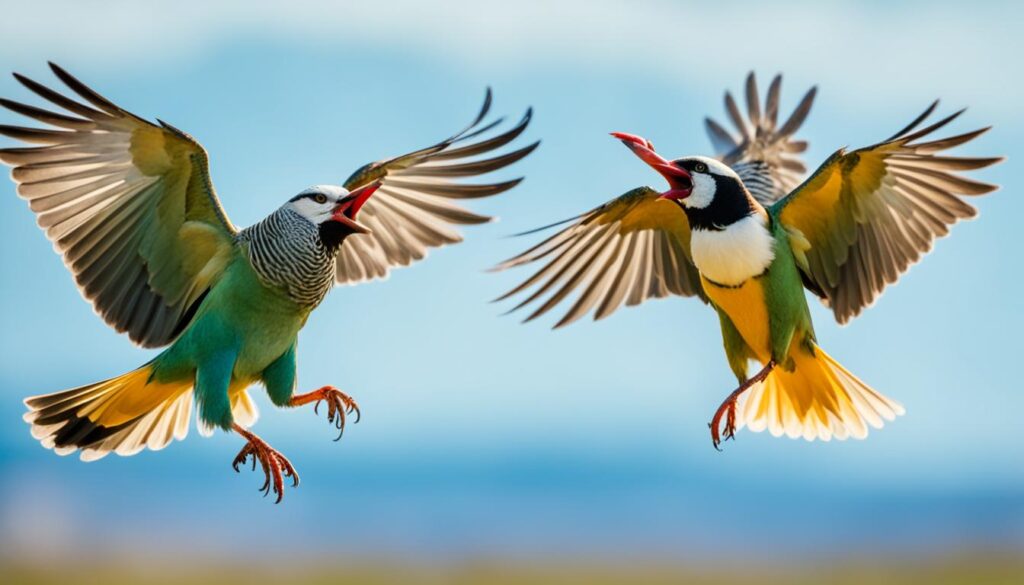

продажа аккаунтов https://birzha-akkauntov-online.ru/
продать аккаунт marketplace-akkauntov-top.ru/
профиль с подписчиками аккаунты с балансом
профиль с подписчиками https://ploshadka-prodazha-akkauntov.ru/
продажа аккаунтов заработок на аккаунтах
продажа аккаунтов соцсетей купить аккаунт
безопасная сделка аккаунтов маркетплейс аккаунтов
Buy and Sell Accounts Account Trading Service
Account Market Account Selling Service
Online Account Store Secure Account Purchasing Platform
Guaranteed Accounts Social media account marketplace
Account Buying Platform Ready-Made Accounts for Sale
Ready-Made Accounts for Sale Account Buying Platform
Guaranteed Accounts Buy accounts
Guaranteed Accounts Ready-Made Accounts for Sale
Account Purchase accountsmarketplaceonline.com
Account Buying Service Account Store
Guaranteed Accounts Account marketplace
account market find accounts for sale
account purchase account market
verified accounts for sale account buying service
find accounts for sale account purchase
account acquisition guaranteed accounts
account acquisition account trading platform
account buying service secure account sales
account buying platform account trading platform
sell account https://socialaccountsshop.com
buy pre-made account accounts for sale
sell accounts sell accounts
account sale buy pre-made account
account buying service secure account sales
buy and sell accounts account marketplace
accounts marketplace find accounts for sale
account market account sale
social media account marketplace find accounts for sale
profitable account sales account marketplace
account exchange service gaming account marketplace
verified accounts for sale buy account
buy account accounts marketplace
sell account sell accounts
account buying platform marketplace for ready-made accounts
database of accounts for sale account trading
account market accounts for sale
account selling service secure account sales
social media account marketplace sell accounts
online account store account marketplace
account marketplace accounts market
account exchange https://buy-best-accounts.org
account exchange https://social-accounts-marketplaces.live
account purchase https://accounts-marketplace.live/
account buying platform https://social-accounts-marketplace.xyz
website for selling accounts https://buy-accounts.space
profitable account sales https://buy-accounts-shop.pro
account trading platform https://accounts-marketplace.art
account trading service https://social-accounts-marketplace.live
account buying platform https://buy-accounts.live/
guaranteed accounts https://accounts-marketplace.online
account trading platform https://accounts-marketplace-best.pro
продать аккаунт купить аккаунт
магазин аккаунтов https://kupit-akkaunt.xyz
магазин аккаунтов https://rynok-akkauntov.top
маркетплейс аккаунтов соцсетей akkaunt-magazin.online
биржа аккаунтов akkaunty-market.live
продажа аккаунтов https://kupit-akkaunty-market.xyz/
продажа аккаунтов akkaunty-optom.live
маркетплейс аккаунтов https://online-akkaunty-magazin.xyz
биржа аккаунтов https://akkaunty-dlya-prodazhi.pro
покупка аккаунтов https://kupit-akkaunt.online/
facebook accounts to buy https://buy-adsaccounts.work
buy aged facebook ads account facebook ad accounts for sale
buy old facebook account for ads https://buy-ad-account.top
buy facebook ads account https://buy-ads-account.click/
buy facebook accounts cheap https://ad-account-buy.top
buy facebook account https://buy-ads-account.work
facebook ad account buy buy fb ad account
facebook accounts to buy buy aged facebook ads account
facebook ads accounts https://ad-accounts-for-sale.work
google ads reseller https://buy-ads-account.top/
buy google ads verified account https://buy-ads-accounts.click
buy facebook ad account https://buy-accounts.click
google ads account for sale https://ads-account-for-sale.top
google ads account for sale https://ads-account-buy.work
google ads accounts for sale https://buy-ads-invoice-account.top
google ads reseller buy aged google ads accounts
buy google ads invoice account google ads account seller
buy google adwords accounts https://sell-ads-account.click
google ads account seller https://buy-verified-ads-account.work
facebook verified business manager for sale facebook bm account
buy google agency account https://ads-agency-account-buy.click